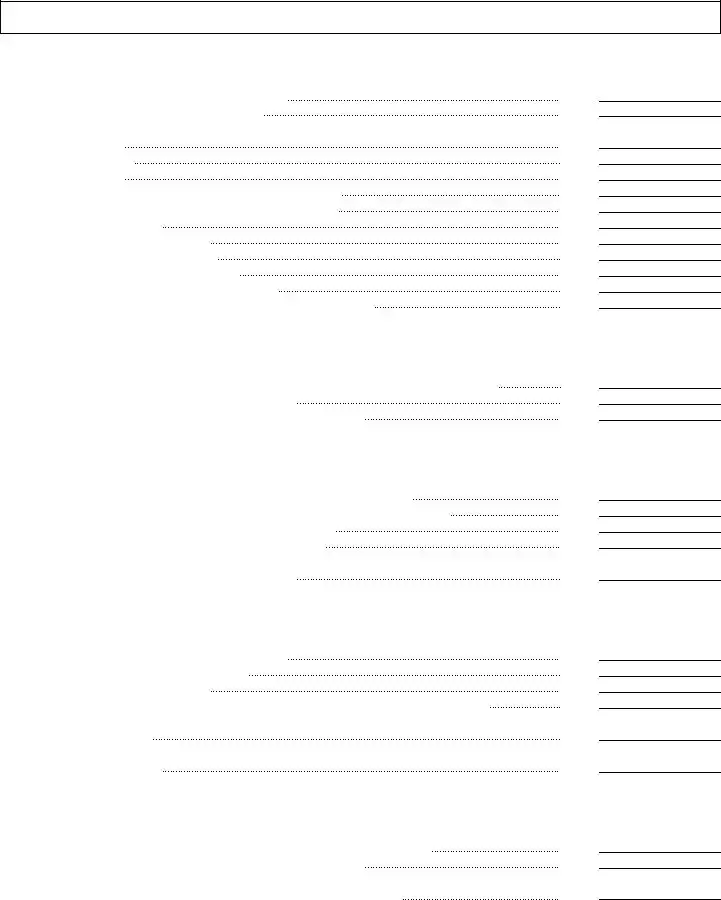GENERAL INSTRUCTIONS
Who may file a return
Aflow-through entity, defined as partnerships, S corporations, limited partnerships, limited liability companies, or limited liability partnerships, that does business in Michigan and has two or more nonresident partners, shareholders or members (participants). The entity (firm) and participants must agree to comply with the Michigan Department of Treasury (Treasury) rules described below.
Participation Requirements
A member may not participate in this composite return in any of the following cases:
•If he or she is claiming a city income tax credit, public contribution credit, community foundation credit, homeless shelter/food bank credit, college tuition credit or Michigan Historic Preservation Tax Credit.
•If he or she was a Michigan resident (full-year or part-year).
•If he or she wishes to claim more than one Michigan exemption.
Due date of return
The composite return for any tax periods ending in 2004 is due April 15, 2005. The returns for any periods ending in 2005 will be due April 15, 2006.
If the firm cannot file by the due date, a request for an extension can be filed before the original due date. See “Requesting an Extension” on this page.
Withholding tax payments
Composite filers are required to make withholding tax payments on behalf of
all nonresident members (both participating and nonparticipating). The payment of withholding is due quarterly on April 20, July 20, and October 20 of the taxable year and January 20 of the succeeding year. The payment of withholding taxes is remitted on the payment voucher Form 160, Combined Return for Michigan Taxes.
Requesting an extension
The firm may request an extension of time to file by sending payment of the estimated annual liability to Treasury with a copy of an approved federal extension. Any extension allowed by the
Internal Revenue Service for filing the firm’s federal return automatically extends the due date of the composite return to the same extended due date.
If the firm does not apply for a federal extension, request an Application for Extension of Time to File Michigan Tax Returns (Form 4). When completing the extension form, check “Fiduciary Tax” in box 1, use the firm’s name and federal employer identification number (FEIN) and write “composite return” on the form. Follow these special instructions to make sure your account is credited properly.
Payment of the estimated annual liability
must be made with the extension application. When you file your composite return, attach a copy of your extension application to it. Obtain Form MI-1041ES
from www.michigan.gov/treasury, Fiduciary Forms. Download a copy of the quarterly forms and complete one quarterly form. Use the name of the firm and the firm’s FEIN or the recipients Social Security number (SSN). Check the box labeled “CF” at the top of the voucher. Do not use the other three quarterly estimate forms.
Mailing refunds, assessments and correspondence
By signing the Michigan Composite Income Tax Return (Form 807), the signing partner or officer declares that the firm has power of attorney from each participant to file a composite return on his or her behalf. Treasury will mail refund
checks, assessments and all correspondence to the firm at the address indicated on the return. The firm must agree to be responsible for the payment of any additional tax, interest and penalties as finally determined. Issues involving the tax liability reported on a composite return will be resolved with the firm. In unusual circumstances, the department may contact the participants.
Attachments
Attach the following items to the composite return:
•A copy of pages 1, 2 and 3 of the U.S. 1065 or U.S. 1120S .
•A Michigan Schedule of Apportion- ment (Form MI-1040H).
•All required forms MI-NR-K1 for each member of the composite return.
•Two schedules (one for participants and one for nonparticipants) listing each partner’s, shareholder’s or member's name, address, SSN and respective share of Michigan income and/or loss. If the participating member is another flow-through entity, the schedule must include the entity’s name, address, FEIN, and share of Michigan-sourced income, as well as a list of the names, addresses, SSNs and ownership percentages of that entity’s nonresident partners or shareholders.
•A statement signed by an authorized officer or general partner certifying that each participant has been informed of the terms and conditions of this program.
LINE-BY-LINE INSTRUCTIONS
Lines not listed are explained on the form.
Line 10: Enter the apportionment percentage from Form MI-1040H. DO NOT
use the Single Business Tax apportionment percentage from Form C-8000H. The MI-1040H apportionment percentage is NOT weighted and the property factors are based on property owned or rented and USED in Michigan. See MI-1040H instructions for income tax nexus standards.
Line 13: The amount on this line should equal the total of lines 14, 15 and 16.
Line 21: Multiply the amount on line 20 by 3.95 percent (.0395).
Line 23: Enter the amount of withholding tax payments made on behalf of participating members.
Flow-Through Entities. Flow-through entities are required to withhold Michigan income tax on the taxable income available for distribution to nonresident members.
The amount of withholding is calculated and remitted on a quarterly basis by multiplying the share of taxable income allocable to each member, adjusted for the allowable exemption amount for a quarter, times the income tax rate (4.0 percent through June 30, 2004 and 3.9 percent beginning July 1, 2004).
Aflow-through entity is also required to withhold Michigan income tax when one or more of the entity’s members is a



